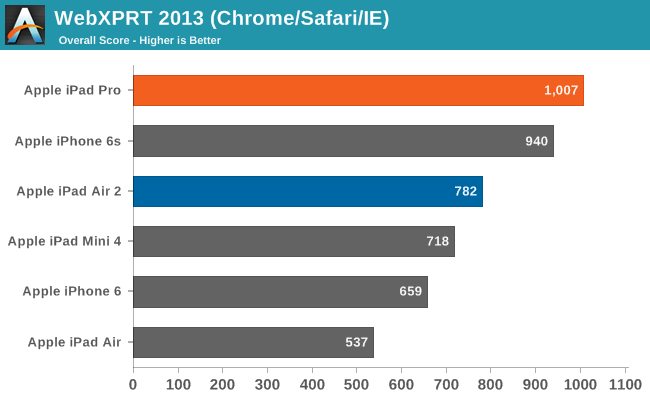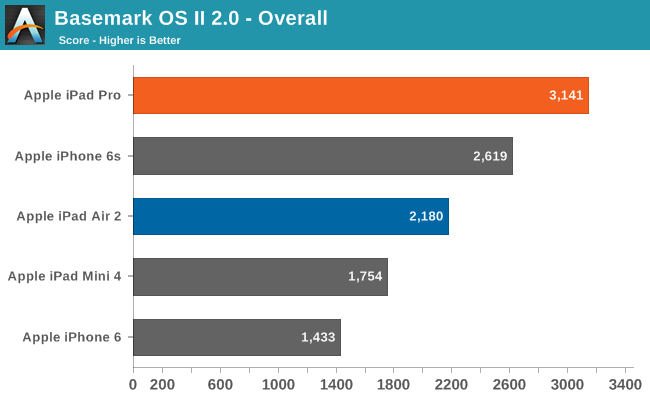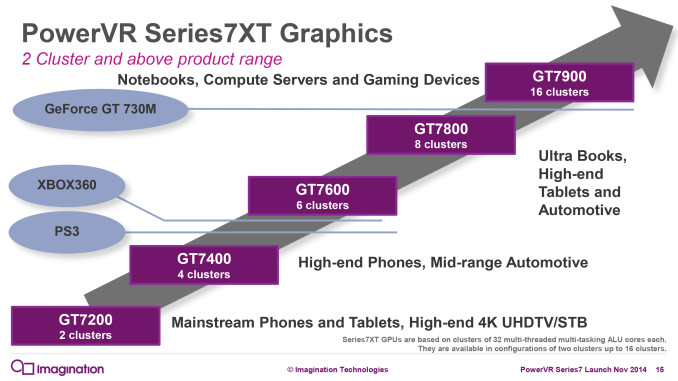The iPad Pro Preview: Taking Notes With iPad Pro
by Joshua Ho & Ryan Smith on November 11, 2015 7:00 AM ESTThe A9X SoC & More To Come
Finally, as everyone is undoubtedly eagerly anticipating our look at the A9X SoC inside the iPad Pro, let’s take a very quick look at what we know about the SoC so far. There’s a bit of a limit to what we can do blindly via just software, but I’m hoping that the eventual A9X die shots will confirm some of our suspicions on A9X’s configuration.
| Apple SoC Comparison | ||||||
| A9X | A9 | A8X | A6X | |||
| CPU | 2x Twister | 2x Twister | 3x Typhoon | 2x Swift | ||
| CPU Clockspeed | 2.26GHz | 1.85GHz | 1.5GHz | 1.3GHz | ||
| GPU | PVR 10 cluster Series7? | PVR GT7600 | Apple/PVR GXA6850 | PVR SGX554 MP4 | ||
| RAM | 4GB LPDDR4 | 2GB LPDDR4 | 2GB LPDDR3 | 1GB LPDDR2 | ||
| Memory Bus Width | 128-bit | 64-bit | 128-bit | 128-bit | ||
| Memory Bandwidth | 51.2GB/sec | 25.6GB/sec | 25.6GB/sec | 17.1GB/sec | ||
| L2 Cache | 3MB | 3MB | 2MB | 1MB | ||
| Manufacturing Process | Unknown (TSMC 16nm or Samsung 14nm) |
TSMC 16nm & Samsung 14nm |
TSMC 20nm | Samsung 32nm | ||
First and foremost, the most unexpected news here is that unlike A8X, A9X is not packing a triple-core CPU. Instead A9X drops back down to just a pair of Twister CPU cores. The twist here is that relative to A8X and A9, Apple has cranked up their CPU clockspeeds. Way, way up. Whereas the iPad Air 2 (A8X) shipped at 1.5GHz and the iPhone 6s (A9) at 1.85GHz, the A9X sees Apple push their clockspeed to 2.26GHz. Not counting the architectural changes, this is 22% higher clocked than the A9 and 51% higher than the A8X.
The fact that Apple dropped back down to 2 CPU cores is unexpected given that we don’t expect Apple to ever go backwards in such a fashion, and while we’ll never know the official reason for everything Apple does, in retrospect I’m starting to think that A8X was an anomaly and Apple didn’t really want a tri-core CPU in the first place. A8X came at a time where Apple was bound by TSMC’s 20nm process and couldn’t drive up their clockspeeds without vastly increasing power consumption, so a third core was a far more power effective option.


By comparison, with the FinFET process Apple is using here – and given the lower volume of A9X I don’t have reason to believe it’s dual-sourced, so it’s either TSMC or Samsung – Apple has been free to increase their clockspeeds substantially. At the same time these FinFET processes are still new and yields won’t be great, so there is a strong incentive to keep die sizes down to keep yields up, and adding a third core would only make that harder. If I had to guess, Apple only wanted two cores to begin with – this makes it easier for developers knowing that they only have two cores to work with – and that it’s A8X that is the anomaly.
Otherwise a highly clocked CPU is far more in-line with Apple’s design philosophy as it means that A9X is capable of amazing single-threaded performance – and keep in mind that we’re talking ARM Cortex-A57-like clockspeeds for a CPU that gets much more work done per cycle – so what we see here makes a lot of sense. Plus with iPad Pro in particular Apple has more battery capacity to sustain the power draw of a higher clocked SoC, and more surface area to dissipate that heat, so the usual concerns about power and cooling aren’t quite as pressing. I do wonder if this will impact multitasking performance much, but given what Twister is capable of, I’m not nearly ready to write off a dual-core Twister implementation clocked this high.
Moving on, as is customary for the X-series SoCs from Apple, A9X features what I believe to be a wider 128-bit LPDDR4 memory bus. The memory bandwidth numbers clearly point to a wider bus, and Apple needs the bandwidth to feed a more powerful GPU.
| Geekbench 3 Memory Bandwidth Comparison (1 thread) | ||||||
| Stream Copy | Stream Scale | Stream Add | Stream Triad | |||
| Apple A9X 2.26GHz | 20.8 GB/s | 15.0 GB/s | 15.3 GB/s | 15.1 GB/s | ||
| Apple A8X 1.5GHz | 14.2 GB/s | 7.44 GB/s | 7.54 GB/s | 7.49 GB/s | ||
| A9X Advantage | 46.4% | 101% | 103% | 102% | ||
Which brings us to the last bit of our preview, the GPU. Apple went with a 6 cluster PowerVR Series7 design on A9, and for A9X they have gone with a larger design. Without a die photo it’s basically impossible to determine how many clusters are in use since clockspeed plays such an important role. What we do know is that GPU performance relative to A9 has pretty much doubled, which once again is right in-line with Apple’s usual design goals.

Given what Apple has done with clockspeed on Twister, for the moment I am staking my bet on it being a 10 cluster design with a higher GPU clockspeed than A9 giving us the rest of the performance boost. To be clear here this could also be a 12 cluster design at a similar clockspeed or even an 8 cluster design clocked far higher – we’ll need die shots to confirm – but given all of the options it’s a 10 cluster design that is the best balance between die size and clockspeed, and it would also be the biggest curveball Apple could throw. It should also be noted that PowerVR Series7 certainly supports such a configuration since it’s scalable from 2 to 16 clusters, although in Imagination’s official product catalog they don’t have a name for such a configuration. So for the moment I’m simply calling it a 10 cluster Series7.
Anyhow, we’ll be back later with a full review of the iPad Pro, including the pros and cons of Apple’s first large-format, productivity-oriented tablet, and a full breakdown of the A9X SoC. So until then stay tuned.











199 Comments
View All Comments
lilo777 - Wednesday, November 11, 2015 - link
Apple is God now? I though it was just a cult. Did not you notice that Apple and Samsung SOCs leapfrog each other in performance every year? Qualcomm did this too until they stumbled for one or two years. Most of the performance improvements in the last two years came from the improvements in semiconductor process and PowerVR design. I am not saying that Apple is not doing a good job too but claiming that they are the sole innovators not is just childish.techconc - Wednesday, November 11, 2015 - link
Single core performance is the measure of better design. Throwing in more cores is what you do when you can't improve your design. Most of Apple's competitors are using ARM reference designs.lilo777 - Thursday, November 12, 2015 - link
Single core performance might be a measure of the better design if that is the goal but it might not be. Anandtech authors do pay a lot of attention to it and there are valid reasons but this is just one of the approaches. I see it differently. There are very few tasks on the phone/tablet that require high performance in a first place and those that do in most cases can be parallelized. With that in mind, having four smaller cores could be advantageous because you get:* better performance for the tasks that do require it (four smaller cores will do better than two large cores in most cases)
* better power consumption on typical phone/tablet tasks
Use of ARM reference design in itself is not an issue. Apple not using reference design does not automatically mean that their design is better. It just means that it is different. (it also happens to be good indeed).
solipsism - Wednesday, November 11, 2015 - link
"Did not you notice that Apple and Samsung SOCs leapfrog each other in performance every year?"I haven't seen that at all when equalizing for the same number of cores, same clock rate, and the same TDP. Apple seems to not only be ahead, but increasing that lead.
PS: Apple has a large stake in Imagination Technologies so one could argue that the direction of PowerVR is on their behest.
Zizy - Thursday, November 12, 2015 - link
Why don't you also normalize to the color of the sky and temperature of the sun?What matters is performance and perf/W. Not frequency, not IPC, not number of cores, not anything else. Talking about any other metric than these meaningful ones is a sign of either mental instability or agenda, unless in an extremely few exceptions.
And in performance, single threaded tasks are hugely in Apple favor. Which tasks are relevant here? Some low threaded games and browsing. Multithreaded tasks are very slightly in Android camp favor when Apple releases new parts and go back to somewhat higher advantage when QC/Samsung/... release their new chips. Which tasks are relevant here? Most games and mostly just games.
But... games require GPU way more they need CPU, so whoever has the best GPU will do the best. Apple therefore has a very smart approach - good ST performance to have great web benchmarks, with great GPU to have great games performance, covering almost all bases.
blackcrayon - Thursday, November 12, 2015 - link
"And in performance, single threaded tasks are hugely in Apple favor. Which tasks are relevant here? Some low threaded games and browsing."You're implying that only a minority of tasks benefit from having fewer, faster cores, when it appears to be the majority. And it isn't just "web benchmarks", it's real world web browsing. Anything that relies heavily on javascript is going to be much faster with an equivalent iOS device (probably a combination of hardware and software here).
BehindEnemyLines - Wednesday, November 11, 2015 - link
Ars uses Geekbench across platforms ARM vs. Intel. Anandtech doesn't use Geekbench to compare differences between platform because it has certain issues with SHA-1 testing, which the ARM will decimate x86.Ytterbium - Wednesday, November 11, 2015 - link
Hope you can takes some notes with Surface Pro as comparison? Does OneNote iOS support pencil?solipsism - Wednesday, November 11, 2015 - link
iFixit shows that it contains a Fresco Logic FL1100 4-port USB 3.0 Host Controller. Hopefully we'll see some data transfer tests that can confirm whether the USB is better than 2.0 speeds.iwod - Wednesday, November 11, 2015 - link
The real deal, is in 2017, when Apple moves to TSMC 10nm.Next year it will be TSMC 16nm FFC, that is 10 - 15% better performance / watt basis. 2017 we will see Apple moves to 10nm, That will likely double the performance of the current A9X with Quad Core. And double the GPU performance again.
2017 sounds like a year of iPad.